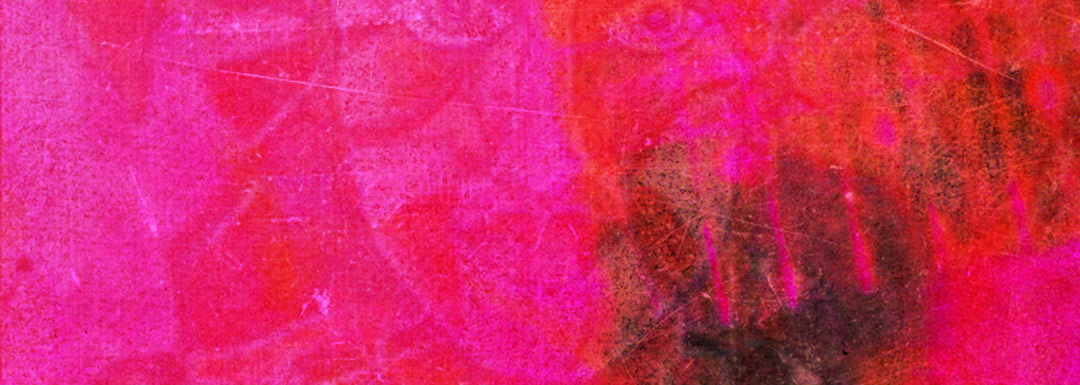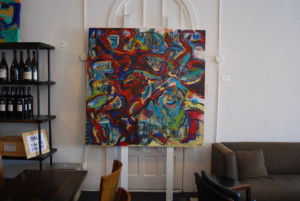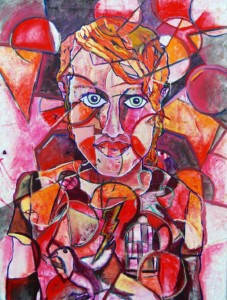Shoegaze, synesthesia, and Music’s inspiration on art in history
Music has been inspiring artists for centuries. From Wassily Kandinsky’s pioneering abstract art to Jackson Pollock’s action paintings, music has been a powerful influence on modern art. For some artists, music is more than just a source of inspiration; it is an integral part of their creative process. This is especially true for artists who experience synesthesia, a condition in which the senses overlap, allowing them to see colors, shapes, and textures in response to sound. In this article, we will explore the fascinating relationship between music and art, with a particular focus on My Bloody Valentine’s albums “Loveless” and “MBV” and their influence on my paintings.
What is Synesthesia?
Synesthesia is a neurological condition where stimulation of one sensory or cognitive pathway leads to automatic and involuntary experiences in another pathway. For example, a synesthete might see colors when they hear certain sounds, or taste specific flavors when they see certain shapes. It is estimated that approximately 4% of the population experiences some form of synesthesia.
Kandinsky’s philosophy and his musically informed art.
Wassily Kandinsky, a Russian artist, believed that art and music shared a common language, and that artists could use the principles of music to create visual works that evoke similar emotional responses. Kandinsky’s book “Concerning the Spiritual in Art” was a significant influence on modern art, and it paved the way for artists to explore the relationship between music and art in new ways.
One such way is through synesthesia, a condition in which the senses overlap, allowing people to see colors, shapes, and textures in response to sound. Synesthesia is a fascinating phenomenon that has captured the imagination of artists for centuries. For some artists, such as myself, synesthesia is an integral part of their creative process. My paintings are often inspired by music, and I experience synesthesia as I paint, seeing colors and shapes in response to the sounds I hear.
So did Kandinsky paint at musical performances?
It is believed that Kandinsky was deeply influenced by music and often compared the experience of painting to that of composing music. He even created a series of paintings that he called “Compositions,” which were inspired by musical structures and rhythms.
However, there is no evidence to suggest that Kandinsky actually painted while attending musical performances. It is more likely that he would have sketched ideas and made notes about the music and its potential visual representations in his sketchbook. These sketches would later serve as inspiration for his abstract paintings.
My painting style developing from Van Gogh style texture to a different approach
In my college years I would paint in a manner more heavily inspired by Van Gogh. Because I was painting for print media in Illustration, this texture would often be lost in translation. It was only when I tried working with implying texture. This lead to me being able to interpret space in a very different manner. I was able to utilize what I heard in these types of songs in a more effective manner.
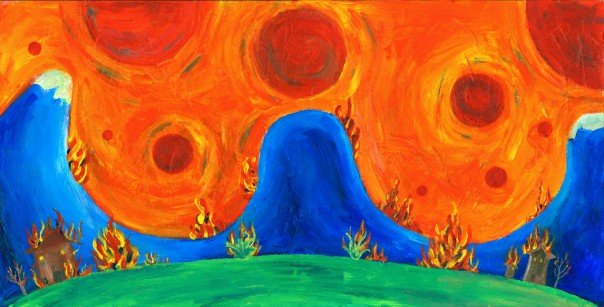
A sample from the children’s book I created at SCAD. This story was based on a Chinese folk tale that I collaborated on with Lena Huang. It made heavy use of textural painting, but a lot of that gets somewhat lost in translation of scanning and editing from it’s original form.
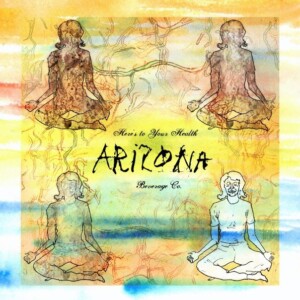
A sample from a digital work I created for my senior portfolio at SCAD mixing hand drawn elements and hand painted elements with digital editing. While I largely considered this portfolio unsuccessful that work heavily influenced the way I think about approaching layering and texture in my art now.
The Who’s “Organized Chaos” and my art
It’s worth mentioning that The Who was a big influence on my early work. My painting “Can You See Me?” was heavily influenced by their early albums, especially songs like “The Seeker”, “Anyway Anyhow Anywhere” and “Naked Eye.”
I’ll preface the next part by saying I studied sound design in college a bit, so I was thinking about sound and space a lot. The first time I heard “Loveless” it was a pretty major revelation. I had never been confronted by music that was equal parts jarring and soothing. Eventually my senses grew attuned to these sounds, but the way I thought about sound, art, colors and shapes was never the same. My long time friend Robert Dauterman gave me a pair of head phones to listen to this album on vinyl. My initial reaction was to feel a bit disoriented, but eventually my senses adjusted.
My Bloody Valentine and Shoegaze as a definitive representation of Synesthesia
One of the bands that have had a significant influence on my paintings is My Bloody Valentine. Their albums “Loveless” and “MBV” are particularly powerful sources of inspiration. My Bloody Valentine’s music is known for its lush, layered soundscapes, and for me, it evokes a range of emotional and sensory responses. When I listen to their music, I see colors, shapes, and textures that I try to capture in my paintings.
Back up, what is “Shoegaze”?
Shoegaze is a subgenre of alternative rock that emerged in the UK in the late 1980s and early 1990s. It is characterized by ethereal, dreamy textures, heavily distorted guitar effects, and hazy, indistinct vocals. The term “shoegaze” comes from the tendency of bands in the genre to stare at their feet while playing, often surrounded by banks of guitar pedals and effects. Other musical groups in this genre that either fit in this description or take major influence include the following: Deftones, Swervedriver, Ride, Smashing Pumpkins, Silversun Pickups, Slowdive, and a lot more.
The name was initially a form of derision. Musical journalist would criticize these bands for their perceived introversion. The reality is that these musicians weren’t necessarily consciously avoiding interactions with their audience. There is some level of more introversion inherent in the music and the performances because the vocals are often buried organically within a huge wall of sound. These groups would often be so focused in switching between multiple affects peddles that they would be “gazing at their shoes.” Some groups like Ride have stated they don’t like the label, but it stuck overall.
Kevin Shields as an influential musical talent.
Kevin Shields, the guitarist and primary songwriter for My Bloody Valentine, is often credited with developing the band’s distinctive “wall of sound” style. Shields experimented with layering multiple guitar tracks and effects, creating a dense and complex sonic texture that became a signature of the Shoegaze genre. The band’s seminal album “Loveless,” released in 1991, is widely considered a masterpiece of the genre and features Shields’ dense, swirling guitar soundscapes prominently. Shields’ innovative approach to guitar playing and production has had a significant influence on a wide range of artists and continues to be celebrated as a groundbreaking achievement in the history of rock music. He also gained notoriety for his work on the soundtrack for the film “Lost in Translation.”
Here’s a playlist of music if you are interested in a bigger picture. Here’s a link to the full playlist.
How my paintings Sentience and “Vanitas #2” reflect Shoegaze’s influence
For example, in my painting “Sentience“, I was inspired by the dreamy, ethereal quality of My Bloody Valentine’s music. A song by Black Rebel Motorcycle Club “Awake” also gave heavy influence with it’s atmospheric qualities. The painting is a swirling mass of colors and shapes that capture the sense of movement and fluidity that I feel when I listen to their music. Similarly, in “Vanitas #2” I was inspired by the melancholy and introspective tone of My Bloody Valentine’s music. The painting is a moody, evocative piece that captures the sense of emotional intensity that I feel when I listen to their music.
My Bloody Valentine’s music is known for its unique approach to sound, characterized by dense layers of guitar noise and distortion that create a complex, textured sonic landscape. This approach to sound has a profound impact on how I visualize shapes and colors in my paintings.
Like a Hurricane being influenced by Shoegaze and Neil young
For example, in “Like a Hurricane”, I was inspired by the dense, swirling sound of My Bloody Valentine’s music. The painting is a mass of overlapping shapes and colors that capture the sense of sonic density and texture that I hear in their music. The layers of guitar noise and distortion in their music create a sense of depth and complexity that I try to capture in my paintings by layering different colors and shapes on top of each other. Neil Young’s song of the same name was also a major influence on this song as it evokes the feeling of being caught in a metaphorical storm. While Neil Young was never an official part of alternative music in the 90’s, he has always been cited as a major influence, especially with similar groups like Sonic Youth.
Sonic layers of texture and implied visual density
Similarly, in “Sentience”, I was inspired by the dreamy, ethereal quality of My Bloody Valentine’s music. The painting is a swirling mass of colors and shapes that capture the sense of movement and fluidity that I feel when I listen to their music. The layers of sound in their music create a sense of motion and energy that I try to capture in my paintings by using curved lines and overlapping shapes.
To conclude, Kevin
Overall, My Bloody Valentine’s music has a profound impact on how I visualize shapes and colors in my paintings. The dense layers of sound and complex textures in their music create a sense of depth and movement that I try to capture in my art. By using color and shape to evoke the emotional and sensory responses that I feel when I listen to their music, I am able to create paintings that are not just inspired by music, but that are a visual expression of it.
My first figurative abstract portrait took literal influence from the concept of Loveless’ “Pink Fuzz” Aesthetic
My first venture into the more figurative side of my art “Lacricia” took very intentional influence from the so called “Pink Fuzz” aesthetic of Loveless. It’s difficult to tell if the design of the album cover informs that association or if you would “see pink” if you had never seen that design. However, I found that to be a compelling bit of stylistic influence.
The overall takeaway
In conclusion, music has been a powerful influence on modern art, inspiring artists to explore the relationship between sound and vision in new and exciting ways. For artists who experience synesthesia, music is an integral part of their creative process, allowing them to see colors, shapes, and textures in response to sound. My Bloody Valentine’s albums “Loveless” and “MBV” are just one example of the many ways in which music can inspire and influence art. As an artist who experiences synesthesia, I have found their music to be a rich source of inspiration, and I look forward to exploring its influence on my future paintings.


